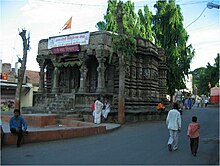Maloji Nimbalkar Naik, II[1]
-
Name Maloji Nimbalkar Naik Suffix II Gender Male Person ID I47 Maratha Empire Last Modified 1 Jun 2014
Children + 1. Umabai Bhosale 2. Vangoji Nimbalkar Naik, II Last Modified 1 Jun 2014 Family ID F24 Group Sheet | Family Chart
-
Sources
- [S15]
WIKI.Phaltan, Wikipedia, (Wikipedia).This article needs additional citations for verification. (November 2009)PhaltanCityCoordinates: 17°59′N 74°26′E / 17.98°N 74.43°E Country  India
India
State Maharashtra District Satara Government • Type Municipal corporation • Body Municipal council Area • Total 10.28 km2 (3.97 sq mi) Elevation 568 m (1,864 ft) Population (2011)• Total 52,118 • Density 5,100/km2 (13,000/sq mi) Demonym Phaltankar Time zone UTC+5:30 (IST) PIN 415523Telephone code 02166 Vehicle registration MH11 Sex ratio Male 1000 / Female 986 ♂/♀ agm Phaltan () is a City, a Tehsil, and a Municipal Council in the Satara district in the Indian state of Maharashtra. The City is about 59 kilometres (37 mi) northeast of the city of Satara and about 110 km from Pune.
History
Phaltan was one of the non-salute Maratha princely states of British India, under the central division of the Bombay presidency. It measured 397 square miles (1,028 km2) in area. According to the 1901 census, the population decreased by 31% to 45,739; the town's population was 9,512 in that year. In 1901, the state enjoyed revenue estimated at £13,000, and paid a tribute of £640 to the British Raj. Its flag was a rectangular bicolor, orange over green.
The Hindu ruling family was descended from Naik Nimbaji Nimbalkar (1284–1291). The ruler had the title of raja or Naik Nimbalkar. Maharani Sai Bhonsale, the first wife of the 17th century Maratha leader Shivaji, was from Phaltan. The last ruler of Phaltan was Major HH Raja Bahadur Shrimant Malojirao Mudhojirao Nanasaheb Naik Nimbalkar IV.
Geography
Phaltan has an average elevation of 568 meters (1,863 feet).
Phaltan's climate is an inland climate of Maharashtra. The temperature ranges from 15 to 45 °C (59 to 113 °F).[1] Summer in Phaltan is comparatively hot and dry when compared to neighboring inland cities. Maximum temperatures exceed 40 °C (104 °F) every summer and typically range between 38–45 °C (100–113 °F). Lows during this season are around 25–28 °C (77–82 °F).
The city receives less rainfall from June to September, and it has been declared as a drought-prone place by the government. Phaltan sometimes does not get rainfall during the rainy season.
Winter starts in Phaltan from November to February. The winter temperatures are significantly higher compared to other cities in Maharashtra such as Pune and Nashik. Lowest temperatures range from 14–16 °C (57–61 °F), while highests are in the range of 29–32 °C (84–90 °F). Humidity is low in this season.
Phaltan crosses a drought-prone area; a dry area is present to the south and south-west of Phaltan, a dry area begins. Water for drinking and irrigation is provided by the Veer Dam on the Nira river.

Dhumalwadi Waterfall 
Jabareshwar Mandir 
Banganga river near phaltan Demographics
According to the 2001 Census of India,[2] Phaltan had a population of 60,172. Males constituted 51% of the population and females 49%. Phaltan has an average literacy rate of 75%, higher than the national average of 59.5%: male literacy is 80%, and female literacy is 70%. In Phaltan, 12% of the population was under six years of age.
Culture
In Ramayana, Phaltan was part of Dandakaranya, and Ram, Laxman, Seeta had come here during Vanvas.
Sri Ram is the local deity (Gram-daivat) of the city, and the Sri Ram Temple in Phaltan is an important landmark in the city.
Phaltan is the birth place of Shri Chakrapani Prabhu, to whom the followers of Mahanubhava Sampradaya consider as an avatara among the 5 Krishnas.[3]
The city also has some ancient Jain temples of historic significance.
Industry

Shriram sahakari sakhar karkhana,phaltan As a tehsil, Phaltan has two sugar factories: New Phaltan Sugar Works Ltd., Sakharwadi and Shri Ram Sahakari Sakhar Karkhana Pvt. Ltd., Phaltan.[4]
Cummins India Ltd. has its 300-acre "mega-site" plant in Phaltan, which is being used to manufacture engines.[5]
Cummins India Ltd. in Phaltan MIDC Education
The Nimbkar Agricultural Research Institute is located in Phaltan. It focuses on agriculture, renewable energy, animal husbandry and sustainable development. Its work on energy self-sufficient tehsils (which became a national policy) was based on the extensive research on biomass availability in Phaltan Taluka.[6][7]
Notable residents
- Sai Bhonsale
- Shivajirao Bhosale
- B. V. Nimbkar, Padma Shri awardee 2006
- Nandini Nimbkar
- Anil K. Rajvanshi, Padma Shri awardee 2022[8]
See also
References
- ↑ Long term weather trends in western Maharashtra
- ↑ "Census of India 2001: Data from the 2001 Census, including cities, villages and towns (Provisional)". Census Commission of India. Archived from the original on 16 June 2004. Retrieved 1 November 2008.
- ↑ R. M. Bhusari, Prachin Maharashtracha Dharmik Itihas (प्राचीन महाराष्ट्राचा धार्मिक इतिहास), Marathi Sahitya Parishad, Hyderabad, 1966, p. 136
- ↑ sugar
- ↑ Agtey Athale, Gouri (18 July 2011). "Cummins India to make Phaltan a true megasite". The Economic Times. Retrieved 10 May 2020.
- ↑ Taluka's can provide critical mass for sustainable development of India
- ↑ Energy Self Sufficient Talukas - A solution to National Energy Crisis; EPW, Vol. 30, Issue No. 51, 23 Dec, 1995
- ↑ Director of Nimbkar Agricultural Research Institute, Anil Rajvanshi selected for Padma Shri
This information is sourced from Wikipedia, the leading online open-content collaborative (crowd-sourced) encyclopedia. Wikipedia and/or TransLiteral Foundations can not guarantee the validaity of content above and can not be held responsible for inaccuracies or libelious information within. Please see Wikipedia General Disclaimer.
- [S15]








Comments | अभिप्राय
Comments written here will be public after appropriate moderation.Like us on Facebook to send us a private message.